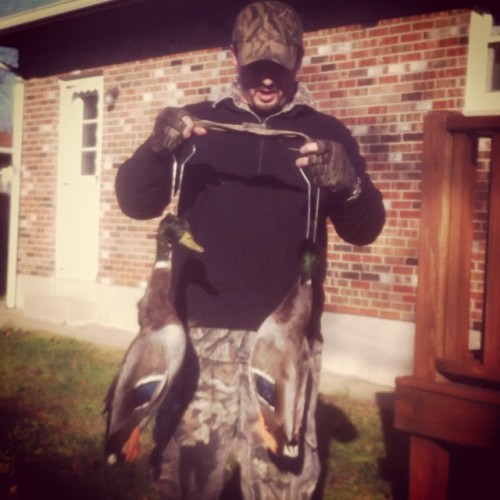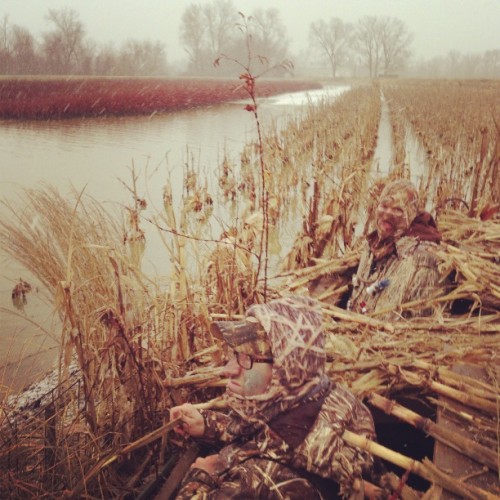by Jon Franko
Anyone who follows me on Twitter knows that this Fall, I spent my fair share of time in the duck blind. Probably more than my fair share actually. Just ask my girlfriend. Or my family. Or my business partner. Or even my neighbors who have been greeted by a lawn full of un-raked leaves for the past 60 days and an alley dumpster full (okay, maybe not full) of feathers on more than one occasion.
Yes – we harvested a good number of ducks this year, but there were many other moments and memories that made the year great. There was the time I ventured out alone for a before-work hunt and bagged two beautiful mallard drakes (pictured below). There was the mythical white duck we chased in vain all season. There were sunrises, sunsets, 4:30am bike rides, and more great mornings with great hunting partners than I deserve.

Looking back, thinking about one obsession of mine (duck hunting) and another (marketing), I couldn’t help but start to draw some parallels between web marketing and waterfowling. I always knew that somewhere, hidden in the 3am wakes-ups and the ice-cold marsh, was a business lesson or two. I knew that somewhere in the chamber of my three shooter or in the decoys that we place out and pick up every day, were some tried and true business principles.
Hey – I was right. Lots of commonalities and business principles in fact. So I compiled the following B2B web-marketing lessons and hope you find them helpful.
You have to have a good product, you have to be where the ducks wanna be
To kill a duck you have to be in a place where that duck wants to be. Period. To make a sale, you have to have a product that people want. Period. No amount of duck calling will convince a duck otherwise. No amount of web-marketing will convince a potential customer otherwise. If your product or service is one that doesn’t have demand, you don’t have a chance at long-term success.
Before you hire a web-marketing agency to build a strong, robust website or before you hire a social media agency to write a custom social media strategy, make sure you’re offering a product that’s being sought out by others. Otherwise, you’ll find yourself staring at empty skies without a buyer or lead in site.
Practice and homework lead to heavy game straps
This past season, I put a lot of time in preparing for the upcoming duck season. I joined a skeet league, practiced my calling, and read and watched everything I could duck and goose hunting related. I did my homework. Not because I’m some blood-thirsty, maniacal duck hunter. But if I was going to put in the time in the field, I wanted to make sure I got the most out of my hunts. Not to mention, I love the sport so I had to get my fix in one way or another.
All of the preparation and homework paid. We had our best season to date.
In B2B web marketing, such preparation is necessary as well. Before you can have any hope of stacking up the leads, you have to do your preparation. Goals need to be made. Keyword research needs to be done. Blogs need to be read. You need to make sure that your website user is finding a website that’s intuitively designed and full of the right calls-to-action. There’s much preparation to do. But doing it will give you a much better chance at marketing success.

Know what works, adjust accordingly
In duck hunting, there are various tactics and tools that we use to attempt to bring ducks in close enough to shoot. Calls, floating decoys, jerk-rigs, motion decoys, full-body decoys, blinds, pits, lay-down blinds – honestly, the list is long. It’s expensively long, in fact. Here’s the good news though – you don’t need everything.
For instance, often this year, on some of my best days in fact, I’d head out to the blind with a few full-bodied decoys, a few floating decoys and a motion decoy. I didn’t have a blind or high-tech concealment and performed minimal calling. But, per the first tip I wrote, I was in a place where the ducks wanted to be and a little reassurance was all that was needed.
The same can be said about business.
Just because you want to start a strong web-marketing initiative, doesn’t mean you have to head out with the whole shooting match. To start, you probably don’t need a $100K website rebuild. You also probably don’t need an active presence on each and every social channel. Email campaigns are most effective when your website can accommodate them with a good blog and lots of new content. And Search Engine Optimization and Pay-Per-Click only work once a strategic foundation has been laid. But, a good, basic website, that’s built to grow and evolve, well, that might be just the ticket.
Just because you have a limited budget, doesn’t mean you can’t make some significant progress and eventually grow that marketing budget. While you might want to eventually test and activate all the different tactics, my advice would be to start small and figure out what works. Know your customer that you’re targeting and grow accordingly.
Hunt smart, market smart
As duck hunters, we have to know what we’re targeting on a given day. We have to know what the birds look like in flight and even be able to identify them in low-light conditions. Anyone who hunts knows that this isn’t as easy as it sounds. Ducks fly fast, show up unexpectedly and require some very quick thinking – especially when you have an itchy trigger finger and are anticipating ducks with every tick of the clock. Before you enter the field, you have to know what you’re targeting and have a thorough understanding of your goals and objectives for the day.
In marketing, knowing your goals and objectives are crucial to your success as well. Before ever thinking about a website rebuild, a social media campaign or an SEO/blog undertaking, you must know what you’re aiming to accomplish and how you’ll measure said success. If you don’t, well, it’ll be tough to prove your campaign’s worth, and even yours if the boss comes a knockin’.
Your website is your decoy spread
As I mentioned earlier in this post, being in the right spot for ducks is the single most important thing you can do. Second, however, is having a realistic decoy spread. Throughout a duck season, that can mean many different things. It can mean having large amounts of decoys with lots of movement at times, and at other times, it can mean a smaller spread with limited movement. Regardless, all the calling you’re doing, the shot shell size you choose, the camo patterns you’re wearing – they all come back to your decoy spread and the spot you’re hunting. In short, this is your home base and it matters greatly.
The same can be said about your company’s website. You can have 10K Likes on Facebook, a strong email campaign, and a big budget PPC initiative. But, if your website isn’t set up to convert leads, to get the ducks to decoy if you will, you’re wasting your time. A lead-generating website is absolutely critical to modern business and if you don’t have one that’s built to work hard for you with smart landing pages and good content, well, to keep it in theme, you’re hunting without decoys.
I recently read a story that noted that the number of people who first research any buying decision online is well north of 90%. Consider that the first pass of the ducks. And when they pass, if there ain’t decoys in the water, the ducks are going to keep beating their wings until they find the guys who are hunting with a well-marketed spread. Similarly, if your website isn’t set up with calls-to-action and information that will pique a reader’s interest time and time again, you’re going home empty-handed.

Let your target come to you
Ducks have extremely keen eyesight so hiding and waiting for them to come to you is typically the most effective way of hunting them. Anyone who has ever tried to sneak up on a group of birds knows that it’s extremely difficult and often leaves you hot, sweaty and holding a goose-egg. So instead, as duck hunters, we set up our decoy spread, hide the best we can, and (attempt) to call the birds to us.
This is very similar to the idea of inbound marketing. In the marketing days of old, we had to constantly use outbound marketing techniques in which we would “go out” and attempt to seek out our consumer to tell them our brand message. But now, with a well-designed website, a strong blogging strategy and good use of the B2B web-marketing channels, we can make our leads come to us. When they come, we capture them and nurture them until the sale happens. It’s a simple theory, that if done with precision and planning, can be relatively simple to execute.
Technology is better
Times are changing. Decoys are better. Calls are better. Camo is better. As duck hunters, we used to head to the marsh with a green coat and dark colored coat. Now, with 3D camo patterns, face masks that are wearable (meaning they don’t drive you crazy) and clothes that are warmer, we have the ability to hunt longer and more effectively.

Hmmm… seems to ring true with marketing too, doesn’t it? Let’s look at the website for instance. What once was a very complicated task, day-to-day updates to your website are simpler than ever. Or at least they should be. At Gorilla, we build all of our websites using a CMS (Content Management System). This makes it easier for us, and our clients, to update their website on a regular basis and encourages effective marketing by doing such. Today, a healthy site is a growing site. This is only possible if a strong CMS is in place.
Above is just one example of how technology is making marketing more effective than ever. The takeaway is this: make sure your B2B company is using the tools available to make the most of your online marketing opportunities.
Record success
This is where my duck nerdom reaches unprecedented levels. Daily, after I hunt, I record the day’s hunt. What the decoys were like, what the weather was like, where I was set up, weather, wind – stuff like that. And of course, I keep track of duck kill as well. With that information, as the year progresses, and even in future seasons, I can reference the data I’ve kept to give myself a better chance of success in the future.
This is true in marketing as well. To replicate success, you must first record and measure it. Whether you choose a down and dirty spreadsheet or a more sophisticated tool, tracking your progress and referencing it from time to time will help you greatly as you continue to pursues a strong web strategy.
As the day comes to a close
Or, as they say, at the end of the day, it’s safe to say that B2B web-marketing and hunting, especially waterfowl hunting, share numerous similarities. Think about your hobbies. What similarities do they share with B2B marketing? How can you use this to make yourself a better marketer?
Happy hunting!